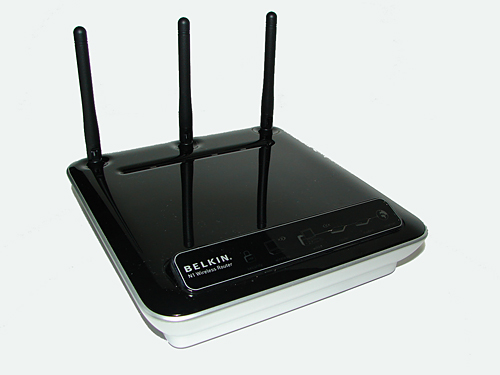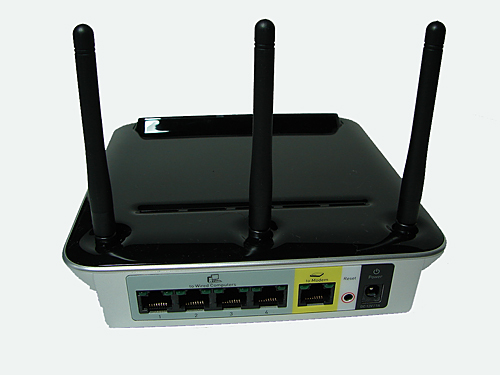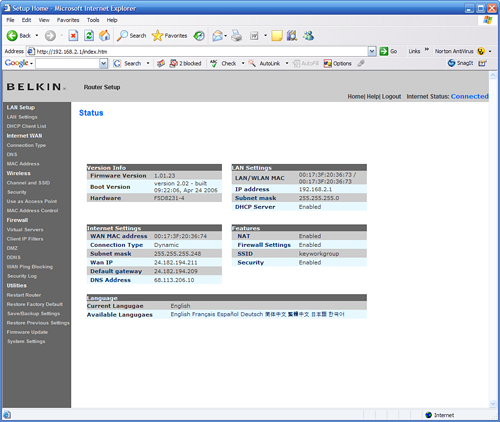Draft N Router Coverage: When the "n" in 802.11n really means "not yet"
by Gary Key on August 30, 2006 5:00 AM EST- Posted in
- Networking
Belkin N1

The Belkin N1 wireless router strongly resembles that of its pre-N based companion with the same basic body and three-antenna configuration. However, the previous slate-gray color scheme has been replaced with a silver and lacquer-black exterior with a new control panel faceplate that ditches the old flashing LED status lights for a new LED based icon display.

The rear setup consists of the standard connections that are labeled and color coded: four 10/100 LAN ports, a WAN port, 12V power jack, and in cases where your setup goes south a reset button.

The most interesting design feature of this router is the new top-mounted display panel that uses an icon based display to show the current connection status of the router and attached systems. This LED based panel features an icon for each of the status points in the network chain. There is a globe representing the Internet; a modem for your DSL or Cable connection; the Belkin router; standard desktop PC for the 10/100 wired connection, a laptop for the wireless connection and a standard lock to show wireless security is enabled (shame on us as ours is not). A solid blue icon signifies that all is well while a blinking amber-colored icon indicates an issue with the particular control point. While this feature is very customer friendly on the desktop, it really does not add instant value if the router is kept in a closet or elsewhere.
Speaking of customer friendly, the entire process from opening up the box until the unit is set up is geared towards keeping the customer properly informed and in control. While this may sound trite, in actuality we had two personnel who had never set up a network complete the installation process in under 15 minutes without needing to ask for assistance at any point. Once you open the box the first item you see is a large instruction guide illustrating the physical connection process in detailed order. Each step is lettered with details in plain English along with a peel off sticker on the router that has the corresponding letters. The boxed accessories such as the included power and networking cables are also labeled with the proper letters.
After setting the physical connections you simply insert the Setup CD and follow a simple series of steps to configure the router and connect to the internet. The automated setup program was without equal as it detected both our DSL and Cable modem settings correctly and had us connected to the Internet and our network in a matter of minutes. After the initial connection was completed the program led us to the browser based utility to set up our wireless encryption.
If you are more familiar with setting up a network you can bypass the automated setup program by hooking up all of the cables and then entering the enclosed IP address to access the network utility program. The utility program was the most informative of the units tested today with very comprehensive explanations for each setting along with a layout that just seemed right when setting up the router. The same can be said of the 103-page PDF based manual as it was clearly the most informative of the units tested today. Belkin offers a limited lifetime warranty on their product along with superb customer service support.

The Belkin N1 wireless router strongly resembles that of its pre-N based companion with the same basic body and three-antenna configuration. However, the previous slate-gray color scheme has been replaced with a silver and lacquer-black exterior with a new control panel faceplate that ditches the old flashing LED status lights for a new LED based icon display.

The rear setup consists of the standard connections that are labeled and color coded: four 10/100 LAN ports, a WAN port, 12V power jack, and in cases where your setup goes south a reset button.

The most interesting design feature of this router is the new top-mounted display panel that uses an icon based display to show the current connection status of the router and attached systems. This LED based panel features an icon for each of the status points in the network chain. There is a globe representing the Internet; a modem for your DSL or Cable connection; the Belkin router; standard desktop PC for the 10/100 wired connection, a laptop for the wireless connection and a standard lock to show wireless security is enabled (shame on us as ours is not). A solid blue icon signifies that all is well while a blinking amber-colored icon indicates an issue with the particular control point. While this feature is very customer friendly on the desktop, it really does not add instant value if the router is kept in a closet or elsewhere.
Speaking of customer friendly, the entire process from opening up the box until the unit is set up is geared towards keeping the customer properly informed and in control. While this may sound trite, in actuality we had two personnel who had never set up a network complete the installation process in under 15 minutes without needing to ask for assistance at any point. Once you open the box the first item you see is a large instruction guide illustrating the physical connection process in detailed order. Each step is lettered with details in plain English along with a peel off sticker on the router that has the corresponding letters. The boxed accessories such as the included power and networking cables are also labeled with the proper letters.
 |
| Click to enlarge |
After setting the physical connections you simply insert the Setup CD and follow a simple series of steps to configure the router and connect to the internet. The automated setup program was without equal as it detected both our DSL and Cable modem settings correctly and had us connected to the Internet and our network in a matter of minutes. After the initial connection was completed the program led us to the browser based utility to set up our wireless encryption.
If you are more familiar with setting up a network you can bypass the automated setup program by hooking up all of the cables and then entering the enclosed IP address to access the network utility program. The utility program was the most informative of the units tested today with very comprehensive explanations for each setting along with a layout that just seemed right when setting up the router. The same can be said of the 103-page PDF based manual as it was clearly the most informative of the units tested today. Belkin offers a limited lifetime warranty on their product along with superb customer service support.










22 Comments
View All Comments
shoRunner - Wednesday, August 30, 2006 - link
As hinted at in the article the overall reliability of these draft-n routers is terrible. Having setup 60+ wireless networks in the past few months using many different kinds of routers including these draft-n routers, they have performed very badly some models requiring daily powercycling and constant firmware updates. If you are looking for a reliable fast wireless network the netgear 240 pre-n router is definately the better buy.Myrandex - Wednesday, August 30, 2006 - link
The Dlink DGL-1000 router has gigabit ethernet and is freaking amazing. Not to mention I enjoy the blue LEDs on the frong, and performance is nice.Jason
blckgrffn - Wednesday, August 30, 2006 - link
If were are going to sustain 300 megabit throughput on our wireless devices, why isn't the wired backend gigabit?Seriously, early adopters of this stuff are also likely to have gigabit networking equipment, as that has been shipping in volume for the at least the last three years or so, and really became affordable as far as switches go last year. My $30 D-link gigabit switch has been working just fine...
Nat
bobsmith1492 - Wednesday, August 30, 2006 - link
On page 2, the feature chart states the three routers have 2.4 GHz bandwidth... I believe that is actually their operating frequency.erwos - Wednesday, August 30, 2006 - link
The spectrum nuking issue is a real concern to me. I live in an apartment building, so I'm already getting crowded by random wireless phones and microwaves all around me. I _shudder_ to think what will happen when some of these "draft 802.11n" devices become more common. I wish I could claim this kind of callousness was because of 802.11n, but I know it's not true - the original channel bonding schemes for 802.11b/g were infamous for this kind of thing.I'm trying my best to be a good citizen and turn that sort of stuff off, but I fear I may to have move to 802.11a, and the less-troubled 5ghz band, soon.
-Erwos
DigitalFreak - Wednesday, August 30, 2006 - link
I moved to 802.11a a long time ago, after more and more b/g APs started showing up. Been running great every since.I really have to wonder why the IEEE didn't use the 5ghz frequency for 11n. I know 11a has a shorter range than 11b/g, but I would think it would be easier to overcome that problem than it is to get past the major spectrum issues in the 2.4Ghz range.
yyrkoon - Wednesday, August 30, 2006 - link
Well, atleast not here in the US I mean.yyrkoon - Wednesday, August 30, 2006 - link
2.4GHZ isnt regulated, 5.8GHZ may be, I'm not sure.Lonyo - Wednesday, August 30, 2006 - link
802.11n might be useful in the home eventually as broadband gets faster (30mbps+ connections), but for real high speed networking, it seems wired is still the only option.Can't say it's so suprising, but at least wireless is getting more useful in terms of matching increasing broadband speeds (although with existing MIMO, .11n isn't quite so useful yet, until it can exceed MIMO).
LoneWolf15 - Wednesday, August 30, 2006 - link
Are you kidding? There are far more reasons for high-speed wireless in the home than just broadband. Streaming media servers (having all my movies, music, etc. on a server that can be streamed to an HTPC or appliance) are a prime example of a good use of high-speed WiFi, especially for those of us that don't wish to deal with rewiring CAT-5 in our houses.As for .11n, it isn't useful yet because there isn't a standard, and yet vendors are trying to capitalize on a need by releasing hastily-designed pre-standard product. It's not robust, and it requires proprietary hardware. When the IEEE finally figures this out (IMO, it should have been some time ago, they've had enough time, though dealing with bickering vendors is an issue) and issues a true standard, things should work out better, much like when V.90 finally was ratified.